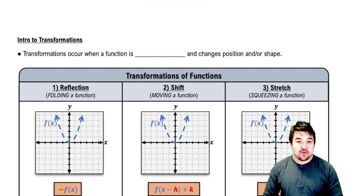Table of contents
- 0. Functions7h 52m
- Introduction to Functions16m
- Piecewise Functions10m
- Properties of Functions9m
- Common Functions1h 8m
- Transformations5m
- Combining Functions27m
- Exponent rules32m
- Exponential Functions28m
- Logarithmic Functions24m
- Properties of Logarithms34m
- Exponential & Logarithmic Equations35m
- Introduction to Trigonometric Functions38m
- Graphs of Trigonometric Functions44m
- Trigonometric Identities47m
- Inverse Trigonometric Functions48m
- 1. Limits and Continuity2h 2m
- 2. Intro to Derivatives1h 33m
- 3. Techniques of Differentiation3h 18m
- 4. Applications of Derivatives2h 38m
- 5. Graphical Applications of Derivatives6h 2m
- 6. Derivatives of Inverse, Exponential, & Logarithmic Functions2h 37m
- 7. Antiderivatives & Indefinite Integrals1h 26m
0. Functions
Transformations
Problem 14c
Textbook Question
Use the graph of f in the figure to plot the following functions.
<IMAGE>
y=f(x−2)
 Verified step by step guidance
Verified step by step guidance1
Identify the transformation involved in the function y = f(x - 2). This represents a horizontal shift of the graph of f(x) to the right by 2 units.
Examine the key points on the original graph of f(x). These points will help in accurately shifting the graph.
Shift each key point of the graph of f(x) 2 units to the right. For example, if a point on f(x) is (a, b), it will become (a+2, b) on the graph of y = f(x - 2).
Redraw the graph using the shifted points to represent y = f(x - 2). Ensure that the shape and orientation of the graph remain unchanged, only the position is altered.
Verify the transformation by checking that all points have been shifted correctly and the overall graph maintains the same features as the original, just translated horizontally.
Recommended similar problem, with video answer:
 Verified Solution
Verified SolutionThis video solution was recommended by our tutors as helpful for the problem above
Video duration:
4mPlay a video:
Was this helpful?

 5:25m
5:25mWatch next
Master Intro to Transformations with a bite sized video explanation from Nick
Start learningRelated Videos
Related Practice


